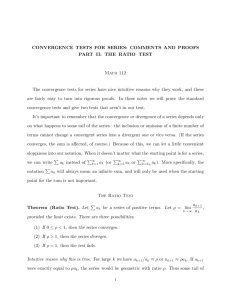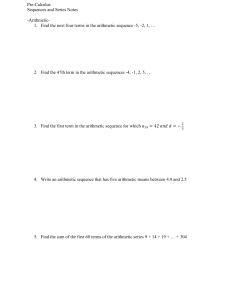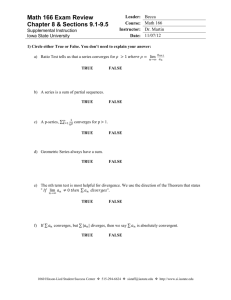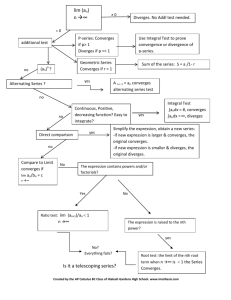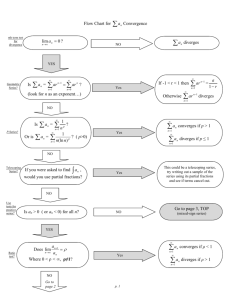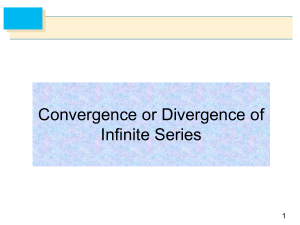Slide 9
advertisement
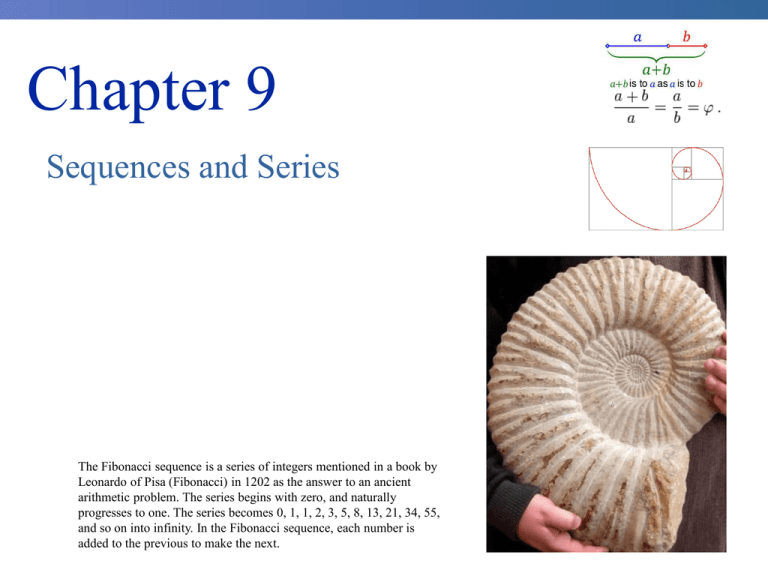
Chapter 9 Sequences and Series The Fibonacci sequence is a series of integers mentioned in a book by Leonardo of Pisa (Fibonacci) in 1202 as the answer to an ancient arithmetic problem. The series begins with zero, and naturally progresses to one. The series becomes 0, 1, 1, 2, 3, 5, 8, 13, 21, 34, 55, and so on into infinity. In the Fibonacci sequence, each number is added to the previous to make the next. 9.1 Overview Example 1 Example 2 Slide 9 - 3 Slide 9 - 4 Slide 9 - 5 Slide 9 - 6 Slide 9 - 7 Slide 9 - 8 Slide 9 - 9 Slide 9 - 10 Sequences and Series A series is the sum of the terms of a sequence. Finite sequences and series have defined first and last terms Infinite sequences and series continue indefinitely. Slide 9 - 11 9.2 Sequences Slide 9 - 13 Practice with examples: a) b) c) p.527 Slide 9 - 14 Definitions: Slide 9 - 15 Examples: Bounded and monotonic. Limit is 1 Bounded but non-monotonic. Limit does not exist Slide 9 - 16 Definitions: Arithmetic and Geometric sequences An arithmetic sequence goes from one term to the next by adding (or subtracting) the same value. Examples: 2, 5, 8, 11, 14,... (add 3 at each step) 7, 3, –1, –5,... (subtract 4 at each step) A geometric sequence goes from one term to the next by multiplying (or dividing) by the same value. Examples: 1, 2, 4, 8, 16,... (multiply by 2 at each step) 81, 27, 9, 3, 1, 1/3,... (divide by 3 at each step) Slide 9 - 17 Slide 9 - 18 Slide 9 - 19 Slide 9 - 20 Slide 9 - 21 Slide 9 - 22 Practice: Slide 9 - 23 Practice: Slide 9 - 24 Practice: Slide 9 - 25 9.3 Infinite Series Recall: A series is the sum of the terms of a sequence. Finite sequences and series have defined first and last terms. Infinite sequences and series continue indefinitely. Slide 9 - 27 Geometric series Constant ratio between successive terms. Example: Geometric series are used throughout mathematics, and they have important applications in physics, engineering, biology, economics, computer science, and finance. Common ratio: the ratio of successive terms in the series Example: The behavior of the terms depends on the common ratio r. Slide 9 - 28 If r is between −1 and +1, the terms of the series become smaller and smaller, and the series converges to a sum. If r is greater than one or less than minus one the terms of the series become larger and larger in magnitude. The sum of the terms also gets larger and larger, and the series has no sum. The series diverges. If r is equal to one, all of the terms of the series are the same. The series diverges. If r is minus one the terms take two values alternately (e.g. 2, −2, 2, −2, 2,... ). The sum of the terms oscillates between two values (e.g. 2, 0, 2, 0, 2,... ). This is a different type of divergence and again the series has no sum. (example Grandi's series: 1 − 1 + 1 − 1 + ···). Slide 9 - 29 Formula: Slide 9 - 30 Practice: Slide 9 - 31 Answers: Slide 9 - 32 Slide 9 - 33 Practice 2: Slide 9 - 34 Answers: Slide 9 - 35 Application of geometric series: Repeating decimals Slide 9 - 36 Telescoping series Slide 9 - 37 A term will cancel with a term that is farther down the list. It’s not always obvious if a series is telescoping or not until you try to get the partial sums and then see if they are in fact telescoping. Slide 9 - 38 9.4 – 9.5 – 9.6 Convergence Tests for Infinite Series Alternating Series Definition of Convergence for an infinite series: Let a n 1 n be an infinite series of positive terms. The series converges if and only if the sequence of partial sums, S n a1 a2 a3 a , converges. This means: lim S n a n n n 1 Divergence Test: If lim a 0, the series n n a n 1 Example: The series n 1 However, n n 1 2 n diverges. is divergent since lim n n n 1 2 lim n 1 1 1 1 n2 lim a n 0 does not imply convergence! n Slide 9 - 40 Geometric Series: a ar ar 2 ar n 1 converges for 1 r 1 a If the series converges, the sum of the series is: 1 r The Geometric Series: 7 Example: The series 5 n 1 8 n with a a1 35 7 and r converges . 8 8 The sum of the series is 35. Slide 9 - 41 p-Series: The Series: 1 p n n 1 and diverges for (called a p-series) converges for p 1 p 1 Example: The series n 1 1 n1.001 is convergent. The series 1 is divergent. n n 1 Slide 9 - 42 Integral test: If f is a continuous, positive, decreasing function on [1, ) with f (n) a n then the series a n 1 n converges if and only if the improper integral f ( x)dx converges. 1 Example: Try the series: 1 3 n 1 n Note: in general for a series of the form: Slide 9 - 43 Comparison test: If the series n 1 (a) If If and b n n 1 is convergent and b is divergent and n 1 n b n 1 (b) a n n are two series with positive terms, then: a n bn an bn for all n, then a n 1 for all n, then a n 1 n n converges. diverges. (smaller than convergent is convergent) (bigger than divergent is divergent) 3n 3n 1 3 2 2 n2 n 2 n2 n n2 n Examples: which is a divergent harmonic series. Since the original series is larger by comparison, it is divergent. 5n 5n 5 1 3 2 3 2 2 n 1 n 2 n n 1 n 1 n 1 2n which is a convergent p-series. Since the original series is smaller by comparison, it is convergent. Slide 9 - 44 Limit Comparison test: If the the series a n 1 where 0c n and b n 1 n are two series with positive terms, and if lim n an c bn then either both series converge or both series diverge. Useful trick: To obtain a series for comparison, omit lower order terms in the numerator and the denominator and then simplify. n n 1 Examples: For the series 2 compare to 2 3 which is a convergent p-series. n 1 n n 3 n 1 n n 1 n 2 For the series n n 3 n 1 n n2 which is a divergent geometric n compare to n 1 3 n 1 3 n n series. Slide 9 - 45 Alternating Series test: If the alternating series 1n 1 bn b1 b2 b3 b4 b5 b6 satisfies: n 1 bn 0 then the series converges. bn bn1 and lim n Definition: Absolute convergence means that the series converges without alternating (all signs and terms are positive). Example: The series n 0 1n n 1 is convergent but not absolutely convergent. (1) n Alternating p-series converges for p > 0. p n n 1 Example: The series n 1 (1) n n ( 1 ) and the Alternating Harmonic series are convergent. n n n 1 Slide 9 - 46 Ratio test: (a) a If lim n1 1 then the series a n converges; n a n 1 n (b) If lim (c) Otherwise, you must use a different test for convergence. an1 1 the series diverges. n a n If this limit is 1, the test is inconclusive and a different test is required. Specifically, the Ratio Test does not work for p-series. Example: Slide 9 - 47 Useful procedure: Apply the following steps when testing for convergence: 1. Does the nth term approach zero as n approaches infinity? If not, the Divergence Test implies the series diverges. 2. Is the series one of the special types - geometric, telescoping, p-series, alternating series? 3. Can the integral test, ratio test, or root test be applied? 4. Can the series be compared in a useful way to one of the special types? Slide 9 - 48 Summary of all tests: Slide 9 - 49
